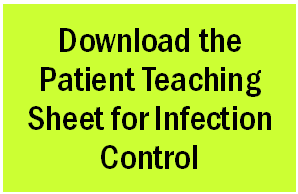Given the current focus on COVID-19, other infectious processes commonly experienced by home health patients - pneumonia, UTI’s, hepatitis, and wound infections - still pose significant challenges to patients and home health clinicians.
Prevention of the Most Common Infections in the Elderly
UTI’s are the most common infection in elderly patients and there are many ways they can be prevented. The number one method for preventing UTIs is reducing the use of urinary catheters by substituting them with more frequent assisted bathroom visits or diaper changes.
Pneumonia – Since pneumonia can be spread through respiratory paths or conta ct with contaminated surfaces, safeguarding the patients’ environment is essential to reducing pathogens. For home health employees, this is especially important. Home health caregivers should always sanitize hands before and after a visit in order to reduce the possibility of introducing pathogens.
ct with contaminated surfaces, safeguarding the patients’ environment is essential to reducing pathogens. For home health employees, this is especially important. Home health caregivers should always sanitize hands before and after a visit in order to reduce the possibility of introducing pathogens.
Wounds – Continually educating staff - and patients - about standard precautions during wound care is a vital component to reducing risk of infection. With precautions and patient teaching, wound infection can be avoided.
Hand Hygiene: One of the Most Important Infection Control Measures
The methods listed above address minimizing the most common infections, however, there are several other methods to ensure hygienic practices during patient visits that can be overlooked. For example: make a habit of sterilizing stethoscopes after each patient visit. Stethoscope diaphragms can harbor Staphylococcus aureus and other bacteria.
Hand hygiene is one of the most crucial elements to reducing infectious pathogens. The selection below from the journal Nursing Made Incredibly Easy (June 2011 Volume 9) outlines several tips for practicing proper hand hygiene:
“Hand hygiene is the most effective way to prevent transmission of infection. Healthcare workers' hands are the most common vehicle for the transmission of healthcare-associated pathogens from patient to patient and within the healthcare environment. Hand hygiene is the leading measure for preventing the spread of antimicrobial resistance and reducing healthcare-acquired infections (HAIs), but healthcare worker compliance with optimal practices remains low in most settings."
Clinicians can reduce the transmission of HAIs by performing hand hygiene consistently before each patient contact, after each patient contact, after contact with environmental surfaces and equipment/medical devices, and before and after donning gloves. Keeping fingernails one-fourth of an inch or less in length and avoiding the use of artificial nails, nail extenders, and nail decorations is necessary to ensure hand hygiene products reach hand surfaces and cuticles. Studies in the medical literature have demonstrated that nearly everything in the healthcare setting-from surfaces, to healthcare workers' hands, to medical equipment-can serve as a reservoir and vector for opportunistic pathogenic organisms. Some bacteria and viruses can live on inanimate objects and surfaces for weeks or even months.
It's important to develop the habit of routinely performing hand hygiene when performing patient-care tasks and procedures or handling medical devices and equipment. Healthcare providers, including nurses, also need to be empowered to hold one another accountable to ensure everyone is compliant with hand hygiene.” Routinely assessing the hygienic practices of home health staff should be a priority for all home health agencies.
Infection Control Teaching for Home Health Patients
-
-
- Wash hands regularly with mild soap. Use over-the-counter antibacterial hand lotions (like “Purell”) regularly when washing with soap and water is not convenient.
- Maintain good overall hygiene including daily bathing with soap and water and application of lotion to dry skin afterwards.
- Concentrate on good nutrition and fluid intake. Balanced diets that include grains, fruits, vegetables, and controlled quantities of fat and protein promote good health and help you resist infection. Your fluid intake should also include 6 to 8 8oz glasses of water daily.
- Perform at least 15 minutes exercise every day. This can include activity as simple as range-of-motion.
- Control stress. Engage in one-full hour of your favorite activity every day.
- Review and discuss infection control measures with your doctor and visiting nurse if an invasive medical procedure is planned.
- Stay current with immunizations.
- Keep the home sanitary, including daily trash removal, disinfection of kitchen and bathroom surfaces, and regular laundering of clothes, household and bed linens.
- Avoid raw or unpasteurized dairy products, and raw or undercooked meat.
- Avoid crowds, visitors, or family members that have a contagious or potentially contagious condition.
- Change air conditioning, heating, vaporizer, and humidifier filters regularly.
-
COVID-19 Home Health Assessment & Careplan
Home Health Coding: Medicare Do's & Don'ts under PDGM
PDGM Home Health Billing: Significant Change in Condition (SCIC)



